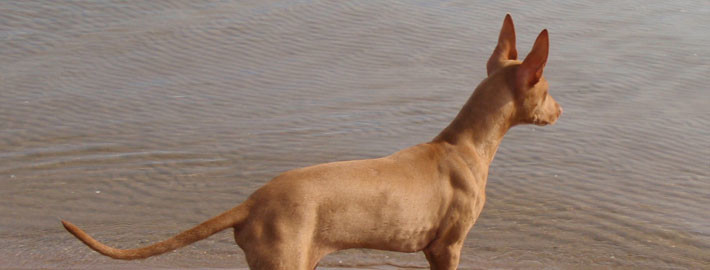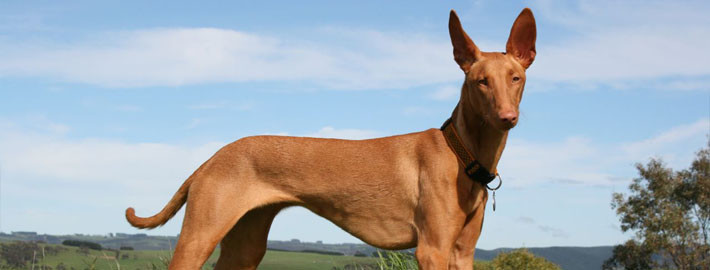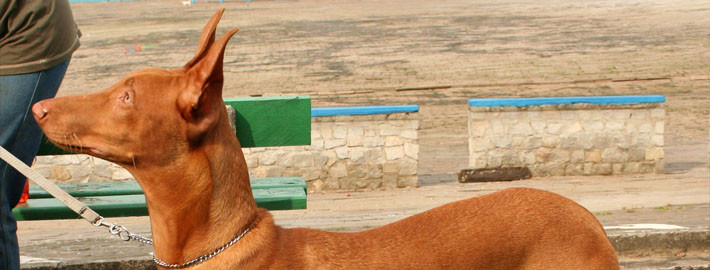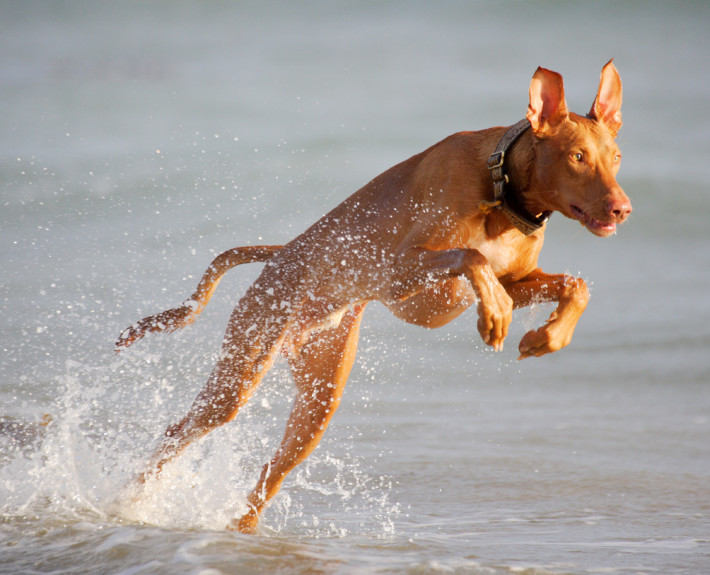What makes the Pharaoh Hound Unique?
More than other breeds, Pharaoh Hounds have a particularly quirky disposition and they’re prone to mischief. They also have the unique trait of flushing pink in the ears and nose when they are excited.
Breed Groups
Page Contents
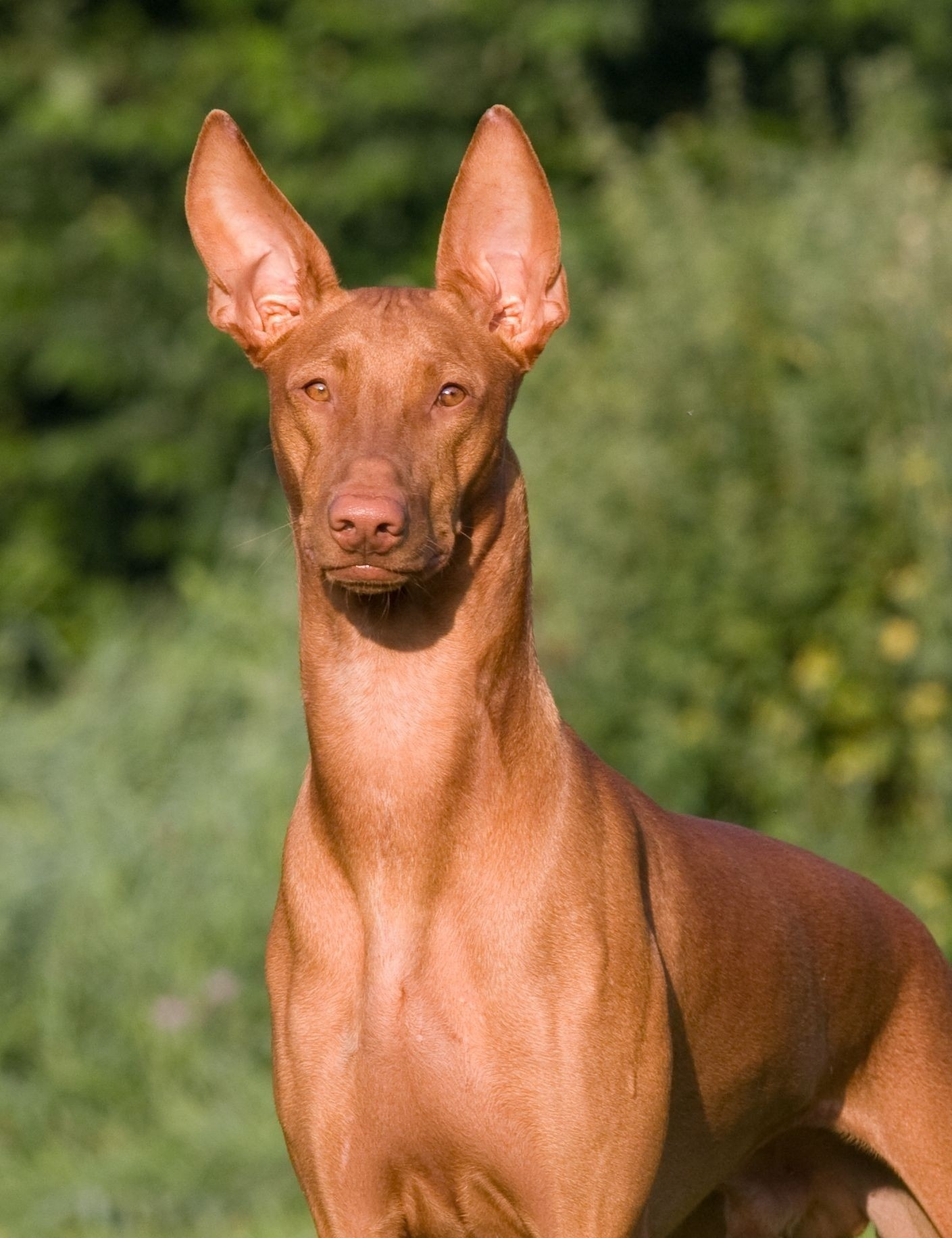
Is the Pharaoh Hound Right For You?
These dogs are affectionate and loyal to members of their own family. They likewise get along quite well with other canines and children. However, Pharaoh Hounds make poor watchdogs as their reaction to strangers varies from wary to downright timid. Although these dogs can mostly entertain themselves, their activities may not amuse their owners. Barking and digging are two of their favorite pastimes but they may be equally content to spend their time lazing about on the couch.
In 5 Words
- Playful
- Intelligent
- Trainable
- Active
- Sociable
Characteristics
Learn About the Pharaoh Hound
Description
General Description
It is said that these athletic dogs resemble greyhounds. Indeed, members of this graceful breed have slim builds and long legs. They are also well-known for their speedy gait. Pharaoh Hounds have a good sense of smell and sizeable ears that benefit them in helping the dogs tracking their prey. The bodies on this breed are somewhat longer than they are tall. Finely formed, wedge-shaped heads and flat skulls are another feature of the Pharaoh Hounds. These dogs also have long, arched necks. The teeth on Pharaoh Hounds should meet in a scissors bite. According to breed standards, a dog’s nose should nearly match its fur. Members of this breed possess small amber colored eyes that are oval-shaped and deeply set. They also have lengthy tails that are larger at the base and taper to a point, much in the same manner as a whip. Removal of the dewclaws is not uncommon.
Size
Males of this breed stand between 22 and 25 inches (55 to 63 centimeters) in height, with females being slightly shorter at 21 to 24 inches (53 to 61 centimeters) tall. Pharaoh Hounds of both genders average a weight of about 40 to 60 pounds (18 to 27 kilograms).
Coat
Members of this breed have short, shiny coat. The American Kennel Club website states that acceptable colorations for this breed include chestnut, red golden, rich tan, and tan. White markings are also permitted but for show dogs this coloration should be limited to the tips of tails.
Short History of the Pharaoh
This breed may have originated about 3,000 years ago Egypt when local dogs were taken to the island of Malta by sailors. Yet others believe that that these dogs came about much later than was previously supposed. In either case, the results were much the same. In their new island homeland, Pharaoh Hounds were bred in isolation for many centuries and this caused their traits to be more clearly defined over time. Whatever the truth might be, the fact remains that members of this breed match both historical descriptions and artwork from much earlier periods.
By the 17th century, the ancestors of today’s Pharaoh Hound had made themselves a reputation for being fine game dogs in areas with difficult terrain. These dogs were often kept to catch rabbits that their human owners could eat, but they are now considered one of the country’s national icons. Historical records show that a few Pharaoh Hounds were exported to Great Britain during the earlier portions of the 20th century. The breed reached America about 30 years later during the 1960s. They were classed as a Miscellaneous breed at first but these dogs were eventually allowed to join the hound group during the 1980s. However, Pharaoh Hounds still remains rare outside of their home country.
Temperament
Pharaoh Hounds were bred for hunting and their personalities display that fact. Owners will definitely need to keep their dogs in a fenced-in area to prevent them from otherwise wandering off in pursuit of prey. While these dogs display placid behavior indoors, what Pharaoh Hounds enjoy most is a good chase. Therefore, members of this breed are not suitable for homes with cats or other small animals.
These dogs are affectionate and loyal to members of their own family. They likewise get along quite well with other canines and children. However, Pharaoh Hounds make poor watchdogs as their reaction to strangers varies from wary to downright timid. Although these dogs can mostly entertain themselves, their activities may not amuse their owners. Barking and digging are two of their favorite pastimes but they may be equally content to spend their time lazing about on the couch.
Caring for Your Pharaoh Hound
General Health
These dogs are born in litters of 7 or 8 pups and live approximately 11 to 14 years on average. Common health problems known to occur in this breed include dysplasia, allergic reactions, bloat, and obesity. These short-coated dogs were bred in a warm portion of the world and, as a result, they should not be left out of doors in cold environments for long periods of time. Therefore owners might want to outfit their pets with jackets or bring them indoors if the weather turns chilly.
Care
Daily
Members of this breed require daily exercise in order to be at their best. Owners should also be aware that the dogs’ predisposition towards bloating means that they should be fed small regular meals every day rather than one large repast.
Weekly
Pharaoh Hounds will also need to have their coats brushed a few times per week. Cleaning a dog’s teeth regularly is likewise recommended to encourage fresh breath and also prevent plaque and tartar buildup.
Monthly
All dogs require flea, heartworm, and tick prevention medication on a regular basis in order to keep them free of parasites.
Grooming & Bathing
Members of this breed shed a moderate amount of fur. Pharaoh Hounds should be bathed only when necessary using a dog shampoo for sensitive skin. They can be rubbed down with a damp towel instead to keep their fur shiny and clean. It is important to keep their nails trimmed and their eyes and ears clean.
Exercise & Training
Training these intelligent dogs is relatively easy, because they learn new commands faster than most other canines. They enjoy food and would presumably respond well to treats as a reward for their hard work. However, owners will have to take care not to overdo the goodies because this breed is prone to obesity. In fact, Pharaoh Hounds greatly benefit from having a secure area to play in. Pharaoh Hounds also enjoy jogging or running with their owners but they should not be allowed off their leashes due to their high prey drive. Because these dogs are known to jump fences, these devices should be upwards of 6 feet (1.5 meters) in order to contain them. Electric fences are ineffective and therefore not advise for containing members of this breed.

